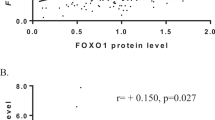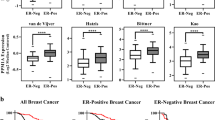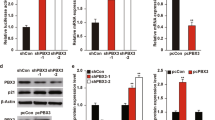Abstract
Breast cancer is the second leading cause of cancer death in North American women. There is considerable need for reliable prognostic markers to assist clinicians in making management decisions. Although a variety of factors have been tested, only tumor stage, grade, size, hormone receptor status, and S-phase fraction are used on a routine basis1. The cell cycle is governed by a family of cyclin-dependent kinases (cdks), which are regulated by associated cyclins and by phosphorylation2. p27Kip1, a cyclin-dependent kinase inhibitor, regulates progression from G1 into S phase by binding and inhibiting cyclin/cdks3,4. p27Kip1 protein levels and/or activity are upregulated by growth inhibitory cytokines including transforming growth factor-β (TGF-β) and, thus, provide an important link between extracellular regulators and the cell cycle5–7. Loss of p27Kip1, a negative cell-cycle regulator, may contribute to oncogenesis and tumor progression. However, p27Kip1 mutations in human tumors are extremely rare8,9. We have demonstrated by immunohistochemistry that p27Kip1 protein levels are reduced in primary breast cancers and that this is associated with tumor progression in both in situ and invasive lesions. This was confirmed by western analysis, reflected in increased G1/S-phase cyclin-dependent kinase activities and shown to be regulated posttranscriptionally by in situ hybridization. Furthermore, on multivariate analysis, low p27Kip1 is a predictor of reduced disease-free survival. This simple and reliable immunohistochemical assay may become a routine part of breast cancer evaluation and may influence patient management.
This is a preview of subscription content, access via your institution
Access options
Subscribe to this journal
Receive 12 print issues and online access
$209.00 per year
only $17.42 per issue
Buy this article
- Purchase on Springer Link
- Instant access to full article PDF
Prices may be subject to local taxes which are calculated during checkout
Similar content being viewed by others
References
Harris, J.R. & Henderson, I.C. Staging and prognostic factors. in Breast Diseases, 2nd edn. (ed. Harris, J. R.) 327–346 (Lippincott, Philadelphia, 1987).
Morgan, D.O. Principles of Cdk regulation. Nature 374 131–134 (1995).
Sherr, C.J. & Roberts, J.M. Inhibitors of mammalian G1, cyclin-dependent kinases. Genes Dev. 9, 1149–1163 (1995).
Reed, S.I. et al. G1 control in mammalian cells. J. Cell Sci. 18 (Suppl.), 69–73 (1994).
Koff, A. et al. Negative regulation of G1 in mammalian cells: Inhibition of cyclin E-dependent kinase by TGF-β. Science 260, 536–539 (1993).
Polyak, K. et al. p27Kip1, a cyclin-Cdk inhibitor, links transforming growth factor-β and contact inhibition to Cell cycle arrest. Genes Dev. 8, 9–22 (1994).
Slingerland, J.M. et al. A novel inhibitor of cyclin/Cdk activity detected in TGF-β arrested epithelial cells. Mol. Cell Biol. 14, 3683–3694 (1994).
Hunter, T. & Pines, P. Cyclins and cancer II: Cyclin D and cdk inhibitors come of age. Cell 79, 573–582 (1994).
Ferrando, A.A. et al. Mutational Analysis of the human cyclin dependent kinase inhibitor p27Kip1 in primary breast carcinomas. Hum. Genet. 97, 91–94 (1996).
Stampfer, M.R. * Bartley, J.C. Induction of transformation and continuous Cell lines from normal human mammary epithelial cells after exposure to benzo[a]pyrene. Proc. Natl Acad. Sci. USA 82, 2392–2398 (1985).
Hengst, L. & Reed, S. Translational control of p27Kip1 accumulation during the Cell cycle. Science 271, 1861–1864 (1996).
Pagano, M. et al. Role of ubiquitin-proteasome pathway in regulating abundance of the cyclin-dependent kinase inhibitor p27. Science 269, 682–685 (1995).
Fang, F. et al. Dependence of cyclin E-Cdk2 kinase activity on cell anchorage. Science 271, 499–502 (1996).
Loda, M. et al. Increased proteasome-dependent degradation of the cyclin-dependent kinase inhibitor p27 in aggressive colorectal carcinomas. Nature Med. 3, 230–233 (1996).
Porter, P. et al. Expression of cell-cycle regulators p27Kip1and cyclin E, alone and in combination, correlate with survival in young breast cancer patients. Nature Med. 3, 222–224 (1996).
Zhu, X. et al. Adhesion-dependent cell cycle progression linked to the expression of cyclin D1, activation of cyclin E-cdk2, and phosphorylation of the retinoblastoma protein. J. Cell Biol. 133, 391 403 (1996).
St Croix, B. et al. Impact of the cyclin dependent kinase inhibitor p27Kip1on adhesion-dependent resistance of tumor cells to anticancer agents. Nature Med. 2, 1204–1210 (1996).
SAS/SAT User's Guide, Version 6, 4th edn., 2, 1027–1069 (The SAS Institute, Inc., Cary, NC, 1989).
Toyoshima, H. & Hunter, T. p27, a novel inhibitor of G1 cyclin-cdk protein kinase activity, is related to p21. Cell 78, 67–74 (1994).
Wang, D., Yeger, H. & Cutz, E. Expression of gastrin-releasing peptide receptor gene in developing lung. Am. J. Respir. Cell Mol. Biol. 14, 409–416 (1996).
Author information
Authors and Affiliations
Rights and permissions
About this article
Cite this article
Catzavelos, C., Bhattacharya, N., Ung, Y. et al. Decreased levels of the cell-cycle inhibitor p27Kip1 protein: Prognostic implications in primary breast cancer. Nat Med 3, 227–230 (1997). https://doi.org/10.1038/nm0297-227
Received:
Accepted:
Issue Date:
DOI: https://doi.org/10.1038/nm0297-227
This article is cited by
-
Endosome associated trafficking regulator 1 promotes tumor growth and invasion of glioblastoma multiforme via inhibiting TNF signaling pathway
Journal of Neuro-Oncology (2024)
-
Bacterial protein MakA causes suppression of tumour cell proliferation via inhibition of PIP5K1α/Akt signalling
Cell Death & Disease (2022)
-
A prospective phase II clinical trial identifying the optimal regimen for carboplatin plus standard backbone of anthracycline and taxane-based chemotherapy in triple negative breast cancer
Medical Oncology (2022)
-
Versatile knowledge guided network inference method for prioritizing key regulatory factors in multi-omics data
Scientific Reports (2021)
-
Cyclin-dependent kinase inhibitor 1B acts as a novel molecule to mediate testosterone synthesis and secretion in mouse Leydig cells by luteinizing hormone (LH) signaling pathway
In Vitro Cellular & Developmental Biology - Animal (2021)



